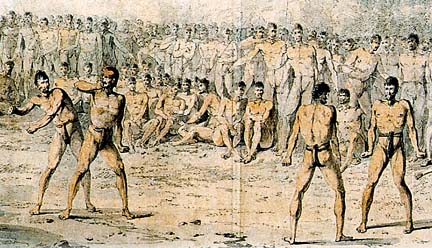

Prehistory to 1780: Ancient Hawaii to
Western Discovery

When Pa‘ao arrived,
so came the age
of forceful aliiThe Society Island priest
By Tom Dye
began a regime of strict
kapu and sacrifice
Special to the Star-BulletinThere have always been alii among the people of Hawaii. But the alii experience wasn't the same from one period to the next.
In an early period that Hawaiian tradition calls Nanaulu, the kapu were not strict. Alii and their subjects were kin, with alii acting the father role in an extended family.
This changed with the arrival of Pa`ao, a priest, chief, navigator and magician who voyaged from the Society Islands to Hawaii about 1100 A.D.
Pa`ao built the first walled heiau, at Waha`ula in what is now Hawaii Volcanoes National Park. The walls kept makaainana away from the worship of the chiefs, since alii believed the commoners would pollute their religious services.
Pa`ao introduced the practice of sacrificing humans on the heiau altars. Human sacrifice wasn't carried out on a large scale. At the height of their power, however, alii killed makaainana often enough that the gentle Keopuolani, sacred wife of Kamehameha I, was praised for never putting any person to death.
Pa`ao established his countryman Pili Ka`ai`ea as an alii in Hawaii. For the first time, Hawaiians were ruled by someone other than a close relative.
Alii discouraged makaainana from keeping genealogies. The genealogies of the alii, meanwhile, were chanted at solemn occasions as evidence of their relationship with the gods.
The chiefs after Pili Ka`ai`ea were often at war. By the time of `Umi, a Hawaii Island alii of the mid-16th century, it was customary for a victorious chief to give newly conquered lands to his supporters. The defeated chiefs, and their people, could be ousted from their lands.
By the early historic period, alii traded lands, and the people who lived on them, among themselves.
It is estimated that one-half to two-thirds of the foods and crafts produced by a makaainana family were taken by the alii for their own use.
Still, the people loved their alii. Songs and chants that glorify alii are performed today, passed down in an unbroken chain over hundreds of years.
Not all alii were good. Makaainana protected themselves by guarding their right to move without penalty from the lands of one alii to another. Alii needed makaainana to make the land productive, so their holdings were at risk if they treated their people worse than neighboring alii did.
Wicked alii incited makaainana to revolt: Tradition records the names of alii who were thrown off their lands by makaainana and of others who were killed.
THE arrival of Capt. James Cook in 1778 was the beginning of the end for the alii.
The productivity of alii lands declined as diseases reduced the number of makaainana workers. Migration to the port towns of Honolulu and Lahaina further depleted the countryside.
The mahele, which granted private property rights in the mid-19th century, destroyed the traditional basis of alii wealth and power. Lands without people to work them were nearly worthless to the alii.
The final blow came with the overthrow of the Hawaiian monarchy in 1893. By that time, the alii were only a shell of their former selves.
Tom Dye graduated from Kailua High School and University
of Hawaii-Manoa before earning his Ph.D. at Yale University. He has
conducted archaeological field research in Tonga, throughout Hawaii,
and in Micronesia for more than 30 years. His publications include
"Heiau of the Island Hawaii: A Historic Survey of Native Hawaiian
Temple Sites." He is currently an archaeologist with International
Archaeological Research Institute, Inc. He serves as president of
the Hawaiian Historical Society and editor of the journal
"Hawaiian Archaeology."
Millennium Series Archive